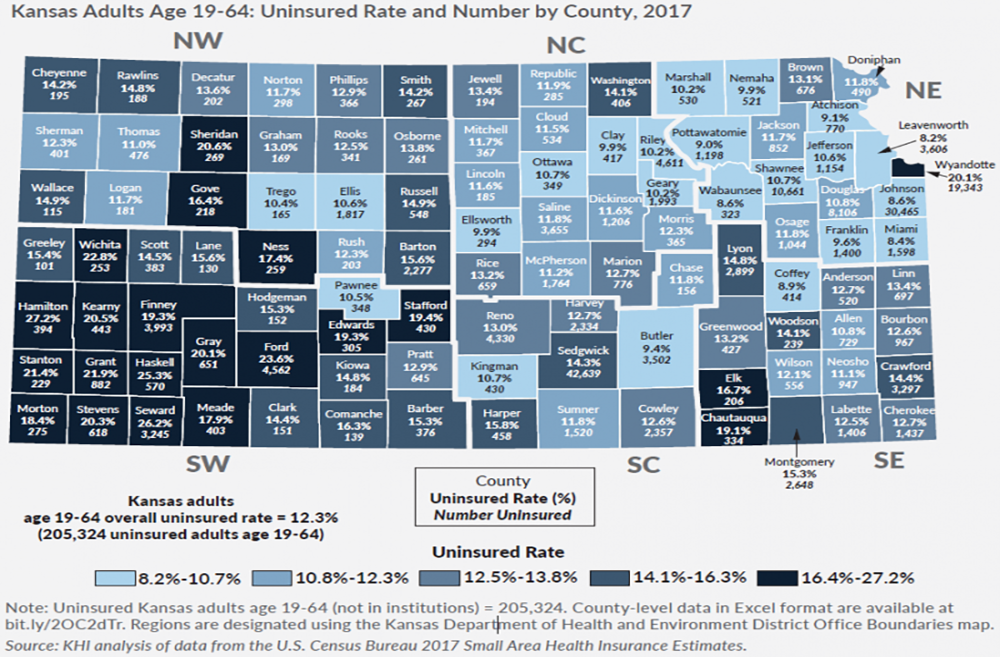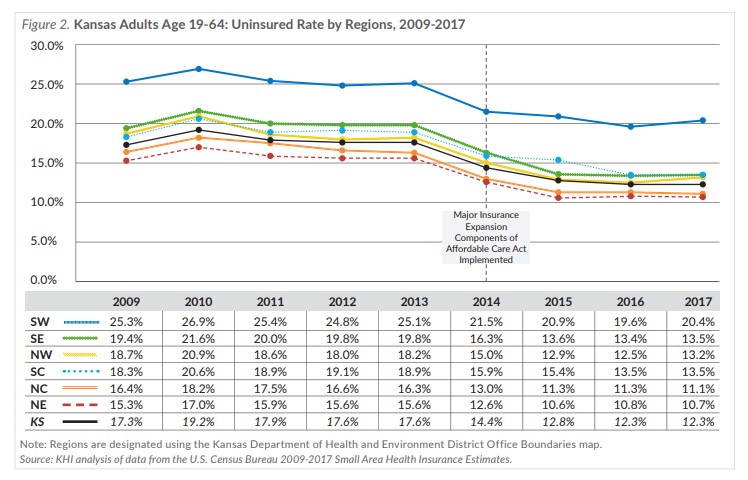While Kansas has made strides in reducing the uninsured rate among nonelderly adults age 19-64, gains in health insurance coverage have stalled in recent years. In 2017, the overall uninsured rate among Kansas nonelderly adults remained unchanged from the previous year at 12.3 percent (205,324 Kansans). This fact sheet examines the county-specific uninsured rate among Kansas nonelderly adults in 2017 (Figure 1, above) — the most recent year for which county-level data are available — and regional changes in the uninsured rate from 2009 to 2017 (Figure 2). It uses data from the U.S. Census Bureau 2017 Small Area Health Insurance Estimates.
Uninsured Rate Among Nonelderly Adults Varies by Region in Kansas
This fact sheet is the first of a three-part series examining the geographic variation in health insurance coverage for Kansans.


Uninsured Rate Varies by County
-
- There was more than a three-fold difference between Kansas counties with the highest and lowest uninsured rate among nonelderly adults in 2017: 27.2 percent in Hamilton County and 8.2 percent in Leavenworth County.
- While most counties with the highest uninsured rates were in the southwest region of the state, Wyandotte County in northeast Kansas also had one of the highest rates (20.1 percent).
Uninsured Rate Has Flattened
-
- The southwest region of Kansas had a consistently higher uninsured rate than other regions in Kansas from 2009 to 2017.
- Between 2013 and 2016, there was a significant decrease in the uninsured rate among nonelderly adults in each region. However, the uninsured rate in all regions has flattened out since 2016.
Discussion
Regardless of where Kansas adults age 19-64 live, insurance coverage has improved since 2009, and the improvement has followed a similar trend across all regions. However, the gap between the southwest and other regions in the state persists. Further analysis of the underlying contributors to the high uninsured rate in the southwest could help communities implement targeted approaches.
Technical Note
The U.S. Census Bureau’s Small Area Health Insurance Estimates (SAHIE) data is the only data source for single-year county-specific estimates for health insurance coverage (http://www.census.gov/programs-surveys/sahie/about.html). SAHIE estimates for health insurance coverage at the state level could differ slightly from those derived from other data sources because of differences in methodology.
Access additional publications in the Documents & Downloads section.
About Kansas Health Institute
The Kansas Health Institute supports effective policymaking through nonpartisan research, education and engagement. KHI believes evidence-based information, objective analysis and civil dialogue enable policy leaders to be champions for a healthier Kansas. Established in 1995 with a multiyear grant from the Kansas Health Foundation, KHI is a nonprofit, nonpartisan educational organization based in Topeka.